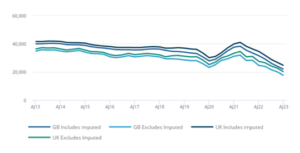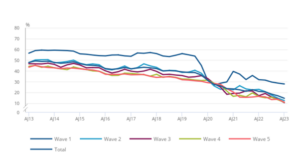Background
The LFS is the main household survey that is used in the compilation of official estimates of the UK labour market.
At the onset of the Covid-19 pandemic all face-to-face interviewing was suspended, and as such, statistics producers needed to respond and consider alternative ways to collect survey data, including for the LFS. At that time, interviews were conducted over the telephone instead of in person. This has remained the primary data collection method for the LFS. In light of the recent data quality concerns face-to-face interviewing has now been reintroduced.
The change in mode to telephone-only affected both the level of response and the non-response bias of the survey and consequently the survey estimates. As the survey transitioned to this new mode, response rates were lower and ONS found the characteristics of those who were responding were not as representative of the population. This was particularly apparent for housing tenure (renters were less likely to respond than homeowners) and country of birth and nationality (those with a non-UK country of birth or nationality were less likely to respond). ONS introduced tenure weighting in October 2020 as a short-term mitigation to methodologically deal with the effects of the change. Further improvement work to deal with the increase in non-response from those with a non-UK country of birth or nationality led to the introduction of new LFS weighting methodology in July 2021, with new population weights introduced using HMRC’s Pay As You Earn Real Time Information (PAYE RTI) data. Reweighted LFS estimates were published in June 2022 using updated PAYE RTI data, as detailed here.
As shown in figures 1 and 2 below, the achieved sample and response rates for the survey have continued to deteriorate, with both now at historical lows (14.6% latest response rate April-June 2023, 21.0% in April-June 2022, 47.9% in April-June 2013). This has resulted in increased volatility and uncertainty in the estimates, particularly for some geographic breakdowns, such as Wales and Scotland. The reduction in the achieved sample also has a greater impact on certain age groups, such as the 16-24 age group, which already has the lowest proportion of achieved responses so is disproportionately affected by drops in sample size. Users have told us that they are concerned that the current weighting methods have added additional uncertainty to current estimates derived from the LFS and note that comparisons of the number of employees show LFS-based estimates growing slower than other indicators, such as PAYE RTI in the post-pandemic period. ONS’s plans during autumn 2023 to conduct an interim reweighting exercise using the latest population estimates have been cancelled due to a delay to ONS plans to publish revised population estimates. The removal of the LFS sample boost in July 2023, which ONS had introduced during the pandemic, has exacerbated the quality issues as the achieved sample reduced further. ONS plans to publish response information for July to September in November 2023 alongside its Labour Market outputs in its LFS performance and quality monitoring report.
Figure 1: Achieved number of household interviews: Great Britain and UK, April to June 2013, to April to June 2023
Source: Figure 1 – Labour Force Survey from the Office for National Statistics
*AJ refers to April to June. Each quarter of the LFS sample is made up of 5 waves. Respondents are interviewed for 5 successive waves at 3-monthly intervals and 20% of the sample is replaced every quarter.
Figure 2: Wave-specific response rates: Great Britain, excluding imputed households, April to June 2012, to April to June 2023
Source: Figure 3 – Labour Force Survey from the office for National Statistics
*AJ refers to April to June. Each quarter of the LFS sample is made up of 5 waves. Respondents are interviewed for 5 successive waves at 3-monthly intervals and 20% of the sample is replaced every quarter.
To improve the quality, coverage, adaptability and responsiveness of the LFS, ONS has been developing a transformed version of the LFS (known as the TLFS) using an online-first multi-mode collection approach with the first iteration of the online survey going live from March 2020. In the meantime, ONS has been dual running the ongoing LFS production with the TLFS developments. ONS has had to make risk-based decisions about the balance of its investment in the TLFS (as the strategic solution to the LFS challenges) while mitigating response and quality concerns with the LFS. ONS had aimed to publish the first set of Labour Market outputs using the TLFS in September 2023, but in April this year ONS announced that it was extending the parallel run of the TLFS for a further six months to allow for extra quality assurance. This extension to the timetable has had an impact on the Labour Market teams within ONS as they have needed to balance the delivery of both the LFS and TLFS.
Back to top



